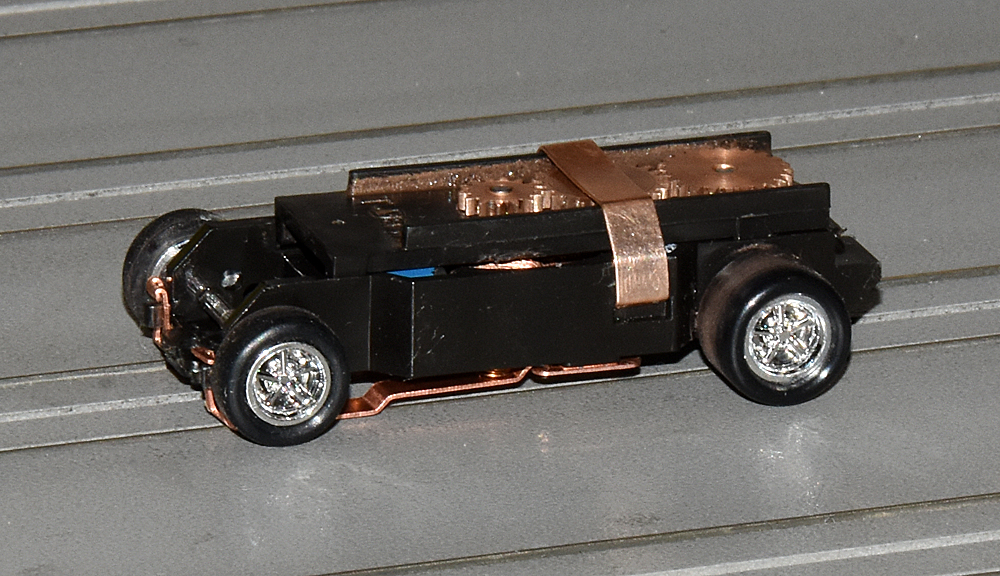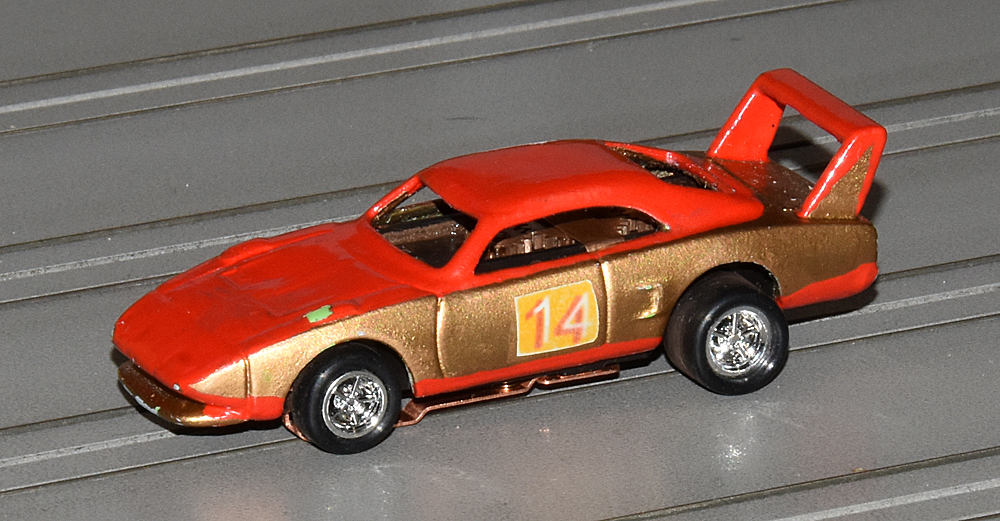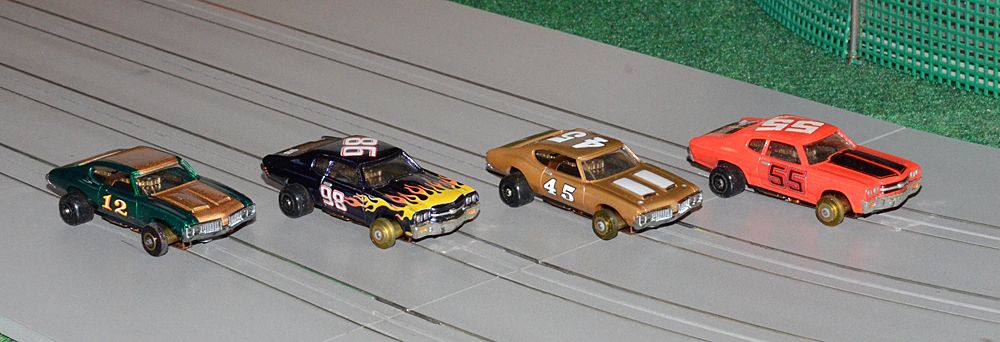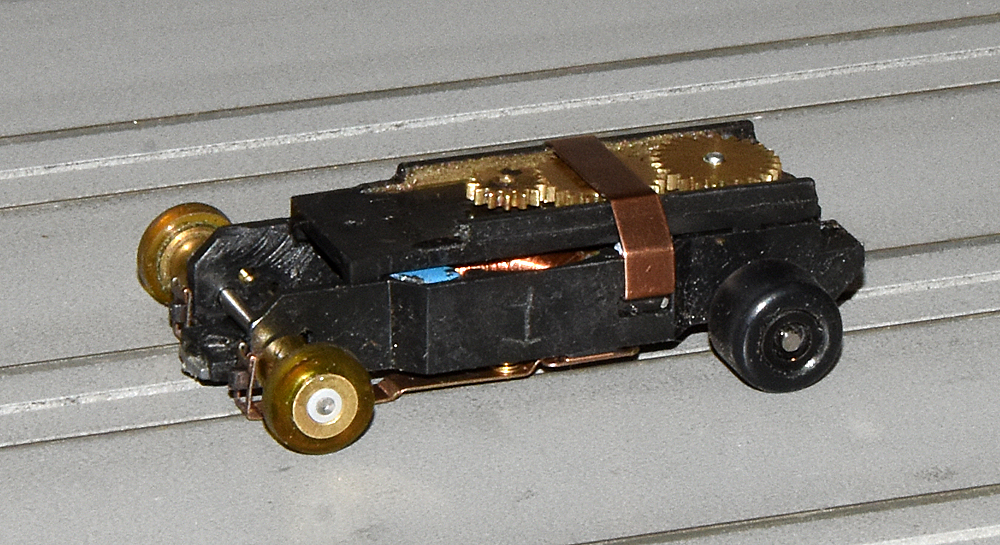T-Dash Generation 2 Testing
I have been testing a T-Dash Generation 2 chassis, those have been difficult to come by because they are made in batches and tend to sell out quickly. You have to go to the website and see when the next batch will be available, if you order within a day of that time you might be in luck. The cars cost $13 plus shipping, there is a discount if you buy five.
For a start all of the Dash parts are interchangeable with the original Aurora Thunderjet parts. The car was supplied with the shoes and shoe springs in a separate bag as were the tires and guide pin. The complete rolling chassis with a guide pin weighs 16.5 grams. I checked the shoe spring pressure and that was about ideal at 3.0 grams. The shoes did not have to be adjusted to ride flat on my track rails. The car has very nice looking American Racing style chromed wheels, the front wheels are 0.253 inches in diameter and the rear wheels are 0.275 inches in diameter. The tires have very good grip, the fronts are 0.385 inches in diameter and the rears are 0.400 inches in diameter.
The front track is 1.025 inches and the rear track is 1.146 inches. The magnets read 746 gauss for the white magnet and 729 gauss for the blue magnet, Dash magnets that I measured several years ago were 850 gauss. The 16-3 armature measured 18.0 ohms on all three poles at 77°F (25°C). The motor brushes are flat on top and have notches on the bottom.
I glued the guide pin to the chassis and found a resin Plymouth Superbird body that was a perfect fit.
After I oiled the car I ran some laps on my MaxTrax 4X16 foot oval using the 35 foot red lane. The track voltage was set at 18.5. The fastest lap was 3.936 seconds, the gears were a little noisy but the car ran smoothly. The idler gear was a perfect fit on its post, the gears were not bottomed out, the axles were not loose in the axle holes, but the armature shaft hole and cluster gear shaft holes in the gear plate were a little loose.
As a comparison I ran four of my 1st generation T-Dash cars around the track. I use those cars for IROC style racing, they have Wizzard weighted front ends, CNC crown gears, drill blank axles, CNC wheels and Pro Series silicone Super Tires. All of the cars had their gears lapped and they had either a '70 Chevelle or Olds 442 body. Those cars are lower and wider than the test car, so they corner better. The best lap times were 3.375, 3.369, 3.148 and 3.215 seconds. The 1st generation cars had 14 ohm 3 lamination armatures.
I tightened up on the gear plate holes and lapped the gears for a total of 45 minutes. The gears resisted lapping and they still sounded a little rough, but the car was a bit faster down the straights. The lap time dropped to 3.661 seconds and I needed to use a fair amount of brake. The limiting factor was mostly the lower cornering speed compared to the IROC cars. Finally I switched to a pair of magnets that were matched at 862 gauss and that got the time down to 3.501 seconds, I still needed brakes. I may configure the car closer to Fray/T-Jet SS trim in the future.
These cars are a real bargain, they can be run right out of the box with little tweaking being necessary to get a decent runner.
For a start all of the Dash parts are interchangeable with the original Aurora Thunderjet parts. The car was supplied with the shoes and shoe springs in a separate bag as were the tires and guide pin. The complete rolling chassis with a guide pin weighs 16.5 grams. I checked the shoe spring pressure and that was about ideal at 3.0 grams. The shoes did not have to be adjusted to ride flat on my track rails. The car has very nice looking American Racing style chromed wheels, the front wheels are 0.253 inches in diameter and the rear wheels are 0.275 inches in diameter. The tires have very good grip, the fronts are 0.385 inches in diameter and the rears are 0.400 inches in diameter.
The front track is 1.025 inches and the rear track is 1.146 inches. The magnets read 746 gauss for the white magnet and 729 gauss for the blue magnet, Dash magnets that I measured several years ago were 850 gauss. The 16-3 armature measured 18.0 ohms on all three poles at 77°F (25°C). The motor brushes are flat on top and have notches on the bottom.
I glued the guide pin to the chassis and found a resin Plymouth Superbird body that was a perfect fit.
After I oiled the car I ran some laps on my MaxTrax 4X16 foot oval using the 35 foot red lane. The track voltage was set at 18.5. The fastest lap was 3.936 seconds, the gears were a little noisy but the car ran smoothly. The idler gear was a perfect fit on its post, the gears were not bottomed out, the axles were not loose in the axle holes, but the armature shaft hole and cluster gear shaft holes in the gear plate were a little loose.
As a comparison I ran four of my 1st generation T-Dash cars around the track. I use those cars for IROC style racing, they have Wizzard weighted front ends, CNC crown gears, drill blank axles, CNC wheels and Pro Series silicone Super Tires. All of the cars had their gears lapped and they had either a '70 Chevelle or Olds 442 body. Those cars are lower and wider than the test car, so they corner better. The best lap times were 3.375, 3.369, 3.148 and 3.215 seconds. The 1st generation cars had 14 ohm 3 lamination armatures.
I tightened up on the gear plate holes and lapped the gears for a total of 45 minutes. The gears resisted lapping and they still sounded a little rough, but the car was a bit faster down the straights. The lap time dropped to 3.661 seconds and I needed to use a fair amount of brake. The limiting factor was mostly the lower cornering speed compared to the IROC cars. Finally I switched to a pair of magnets that were matched at 862 gauss and that got the time down to 3.501 seconds, I still needed brakes. I may configure the car closer to Fray/T-Jet SS trim in the future.
These cars are a real bargain, they can be run right out of the box with little tweaking being necessary to get a decent runner.



